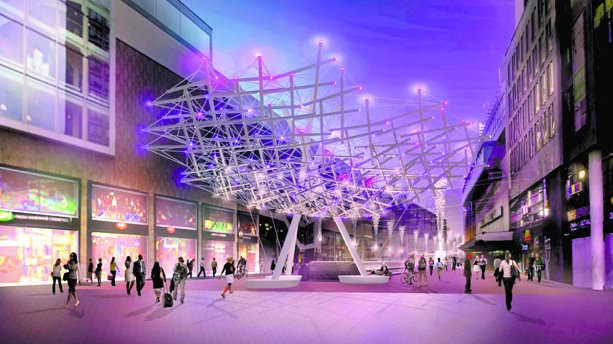Additive manufacturing, better known as 3-D printing, is making inroads into the construction sector, most recently in a project which showed it could be useful in making custom steel structural components.
Salomé Galjaard, a senior product designer with Arup, a global design engineering consultancy, said the project started with the idea that 3-D printing could save time and solve the problem of mass customization.
Based in Amsterdam, she and her colleagues started about 30 months ago, looking at an existing project which required 1,600 steel nodes to connect struts and tension wires with some 1,200 design variations in each component.
The structures were three giant floating outdoor chandeliers at The Hague’s Grote Marktstraat. Fittingly, the designs are for 3-D structures built as a ‘tensegrity’ structure of compression forces and tensile strength. The lighting is built into the structure and adds to the spatial perception.
While the project wouldn’t end up being used in the design, the existing design was fully engineered and therefore a known entity and a good base line to measure against so Arup green-lighted the research retroactively for future reference.
"One of the great things about Arup is that it is employee-owned," she said. "And part of that is being able to make proposals for research projects which is what we did. It’s not a full-time research project but we have hours put aside to work on it."
The first phase was to look at the nodes as traditionally manufactured with steel plate and welds. The team felt additive manufacturing was a better option since each piece could be customized as required with more accuracy.
"I think the biggest hurdle we faced initially was in our own minds," she said. "We have this traditional thinking and it was hard to let go of the way we do things, sheets, struts, cables. Free form isn’t a part of traditional CAD design."
3-D printing with metals involves a process called sintering in which metal powder is melted and shaped by a computer controlled laser.
The team set about creating prototypes knowing the nodes had to have structural integrity and have holes for cables and rods to be bolted to them.
"We looked at the aviation and auto industry where they are already using 3-D printing for rapid prototypes but they weren’t too happy to share with us," she said. "Then we started thinking about where we actually needed material for integrity."
The results were strange yet somehow esthetically appealing and more organic than anything normally produced in a fabrication shop. They were also able to run off 3-D plastic models as prototypes to better visualize what was on their screens.
Interestingly, she said, the first 3-D iterations were 30 per cent lighter, which spurred another phase which was green-lighted to refine the technique even more.
The initial nodes were about 18 inches long and by the second phase they had reduced that in half using stainless steel. They reduced the weight by 75 per cent which in turn led to a recalculation of the entire structure’s stress and loads. It was found they could reduce the amount of materials overall by 40 per cent. The final product also changed somewhat and the mounting points were better integrated.
Since it was a theoretical project to investigate the value of the 3-D process over traditional fabrication, it hasn’t been put into the field. However, the team is confident that it’s something which has proved its worth and could easily be applied where suitable and where mass customization is required.
"Maybe with this architects or engineers can actually base their designs on additive manufacturing which is really exciting," she said.
"You don’t just use less material, it also becomes smaller and easier to transport and store."
Galjaard said the expiry of patents and technology developments in additive manufacturing have come together with software advances to open the door to the concept. However, it is in early stages still as far as construction goes.
She said there are many other applications where structures could be 3-D printed such as in sail boats but there are many more iterations to be done to gain the knowledge and experience needed to understand the process’ capabilities.






Recent Comments
comments for this post are closed